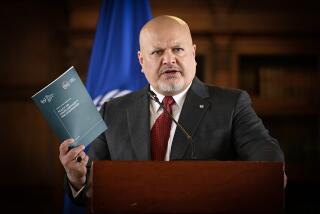Czechoslovakia Confirms It May Possess Banned SS-23s : Arms control: The Prague government discloses there are 72 Soviet-made missiles in its arsenal.
The government of Czechoslovakia has confirmed that its army possesses 72 Soviet-made missiles that could be SS-23s--a type of medium-range missile banned from U.S. and Soviet arsenals by a 1987 treaty, U.S. officials said Thursday.
The disclosure follows a recent admission by East Germany that it has 24 Soviet-made SS-23s. If the Czechoslovak missiles also turn out to be SS-23s, which so far is uncertain, the combined total of 96 would represent about 30% of known Soviet production of the missiles.
The United States has not yet approached the Soviets about the Czechoslovak missiles. In response to the East German disclosure, however, Moscow insisted that it had not violated the terms of the 1987 treaty because ownership of the weapons was transferred before the pact took effect.
Even so, U.S. officials accused the Soviets of “bad faith” in failing to disclose the weapons’ presence in East Germany.
The political consequences of the latest revelation could be significant. The Bush Administration is likely to assert that clandestine transfers of banned missiles, even if not legally barred by the 1987 Intermediate Nuclear Forces treaty, raise serious questions about Soviet veracity.
Unless Moscow provides a satisfactory explanation, new treaties expected to be signed this year to cut nuclear weapons and conventional forces in Europe are likely to face a hostile reception in Congress from conservative Republicans and others worried about Soviet cheating.
In addition, the fact that so many missiles were successfully hidden from the United States’ vaunted spy satellites and other detection equipment will raise doubts that the new and far more important treaties can be effectively monitored.
After the East Germans voluntarily acknowledged last month that they had 24 of the Soviet-made SS-23 missiles in their possession, the United States asked Moscow’s other Warsaw Pact partners if they had the same kind of weapons.
Prague’s reply was received last week, U.S. officials said. Of the remaining four Warsaw Pact nations, those who have answered so far said they have no such weapons, but not all of the replies have been received, the officials said.
It was not clear whether the Czechoslovak weapons are in fact SS-23s, officials cautioned. The Czechoslovaks described their characteristics, such as size and weight, but not their name or other designations.
Some U.S. officials have concluded that the missiles are SS-23s, but others are not certain.
“We’ve asked the Czech government for further information on the possible presence of SS-23 missiles in Czechoslovakia,” said State Department spokesman Richard Boucher. “As we’ve said before, we regard this as a serious matter.”
When the INF treaty was signed, Moscow declared that it possessed 239 SS-23s, all of which were destroyed, according to the U.S. On-Site Inspection Agency, which monitored the destruction.
What advantages the Soviets expected by transferring the SS-23s to East Germany, and possibly Czechoslovakia, is not clear.
Some U.S. officials said they were inclined to believe that the missiles just got “lost” somehow, and they interpreted the episode only as an embarrassing error by Moscow. Others, more suspicious of Soviet intentions, noted that the Soviet military may have intended to hedge on the treaty by leaving missiles in Eastern Europe with local military forces that were, at the time, closely allied with Moscow.
Although the Eastern Europe missile force is relatively small, it is not insignificant, particularly if armed with nuclear warheads. Soviet nuclear depots remain in East Germany and still could hold nuclear warheads for SS-23s. The missiles conceivably could be used by Soviet troops against North Atlantic Treaty Organization forces, which have given up missiles of that range.
The SS-23s might have gone undetected indefinitely if the old, hard-line East European regimes had not collapsed last fall. The reformist East German government disclosed the presence of the SS-23s in February, after which some of the weapons were spotted by U.S. spy satellites.
Responding to U.S. complaints on the East German transfer, Moscow said it had sold or given the SS-23s to the Germans before the INF treaty was signed in December, 1987. As a result, it said, the Soviet Union was under no legal obligation to destroy or even report the disposition of weapons that were no longer under its control.
Washington has indicated that it considers the explanation, while probably accurate, to be unsatisfactory. It has asked for further discussions on the matter.
In making their charge of “bad faith” against the Soviets, U.S. officials noted that the Kremlin made a considerable fuss in 1987 over a similar situation involving U.S.-made Pershing 1 missiles sold to West Germany. Moscow insisted on elimination of West German missiles, although they fell below the 300-to-3,400-mile range encompassed by the treaty and the West Germans were not party to the treaty.
The SS-23s definitely fall within the range of weapons banned by the treaty, although East Germany, like West Germany, was not a signatory. The new East German regime said it would scrap the 24 missiles in its arsenal.
More to Read
Start your day right
Sign up for Essential California for news, features and recommendations from the L.A. Times and beyond in your inbox six days a week.
You may occasionally receive promotional content from the Los Angeles Times.






